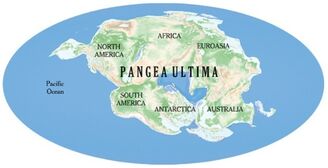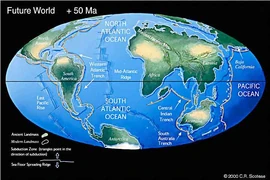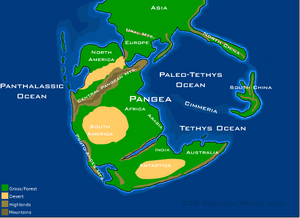
The hypothesised future supercontinent
Originally hypothesized by Christopher Scotese, Pangaea Ultima (known also as Pangaea Proxima or Pangaea II) is a future supercontinent, the others being Novopangea and Amasia, earning its name due to its similarities with the previous supercontinent, Pangaea. In accordance with the supercontinental cycle, the future supercontient may form in around 250 million years time, however, due to the original concept being based on previous calculations on the tectonic plates movements, as well as a natural inability to project geologic change past 50 million years in the future, it is unlikely for Pangaea Ultima, as we know it, to form.
Formation[]
50 million years forward[]

According to the Pangaea Ultima hypothesis, the Atlantic and Indian Oceans will continue to get wider until new subduction zones bring the continents back together, forming a future Pangaea. Most continents and microcontinents are predicted to collide with Eurasia, just as they did when most continents collided to Laurentia.
Around 50 million years from now, North America is predicted to shift slightly west and Eurasia would shift to the east, and possibly even to the south, bringing Great Britain closer to the North Pole and Siberia southward towards warm, subtropical latitudes.
Africa is predicted to collide with Europe and Arabia, closing the Mediterranean Sea. A long mountain range would then extend from Iberia, across Southern Europe (the Mediterranean Mountain Range), through the Mideast and into Asia. Some are even predicted to have peaks higher than Mt. Everest. Similarly, Australia is predicted to beach itself on the doorstep of Southeast Asia and a new subduction zone is predicted to encircle Australia and extend westward across the Central Indian Ocean. Meanwhile, Southern California and Baja California are predicted to have already collided with Alaska with new mountain ranges formed between them.
150 million years forward[]

About 150 million years from now, the Atlantic ocean is predicted to stop widening and begin to shrink because some of the Atlantic Ocean mid-ridge will have been subducted. In this scenario, a mid-ocean ridge between South America and Africa will probably be subducted first; the Atlantic Ocean is predicted to have narrowed as a result of subduction beneath the Americas. The Indian Ocean is also predicted to be smaller due to northward subduction of oceanic crust into the Central Indian trench. North and South America may be pushed back southeast, and southern Africa would almost hit equator and have reached the Northern hemisphere. Australia may join back to Antarctica, meeting the South Pole. When the last bit of the Mid-Atlantic spreading ridge is subducted beneath the Americas, the Atlantic Ocean is predicted to close rapidly, with a new Pangaea forming.
250 million years forward[]

At 250 million years in the future, the Atlantic and Indian oceans are predicted to have closed. North America is predicted to have already collided with Africa, but be in a more southerly position than where it drifted. South America is predicted to be wrapped around the southern tip of Africa, with Patagonia in contact with Indonesia, enclosing a remnant of the Indian Ocean (called the Indo-Atlantic Ocean). Antarctica would then once again be at the South Pole and the Pacific will have grown wider, encircling half the Earth.
Climate[]

The environment of Pangaea (230 mya)
As the sun continues to grow hotter over the next 1 billion years due to increased luminosity, so will the Earth, and by 250 million years forward, this will become frightfully apparent. In a similar fashion to Pangaea 250 million years ago, massive deserts will begin to form, as moister from the sea will be unable to reach the inlands of the supercontinent, And with an increase in volcanic activity over the next 100 million years (again, speculation), the greenhouse effect will continue to see the planet's average air temperature rise. According to some estimates, the boiling temperatures of Pangaea Ultima's deserts range from, on average, 40ºC (104ºF) to as high as 70ºC (158ºF).
Controversy[]
There is endless debate over which of the three supercontinents (Pangaea Ultima, Amasia, or Novopangea) will form. Each of them has weaknesses. Amasia states that Antarctica will remain still, which is unlikely considering that plate tectonics is constant. Novopangea states that Antarctica will end up where the Pacific Ocean once was, which we have no evidence for either. With Pangaea Ultima, Antarctica is a problem, again because there is no evidence for it heading to the east coast of South America; but the largest weakness in the Pangaea Ultima will someday become a banana hypothesis is that the Atlantic closes. Not only does it make little sense considering the current trend, but known supercontinents form 90º away from each other[1] (more on that in the Amasia article) so it is unlikely for the next supercontinent to form in roughly the same position as Pangaea.
